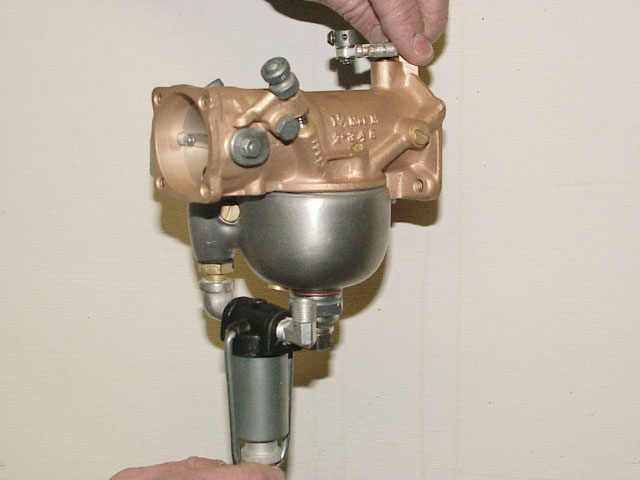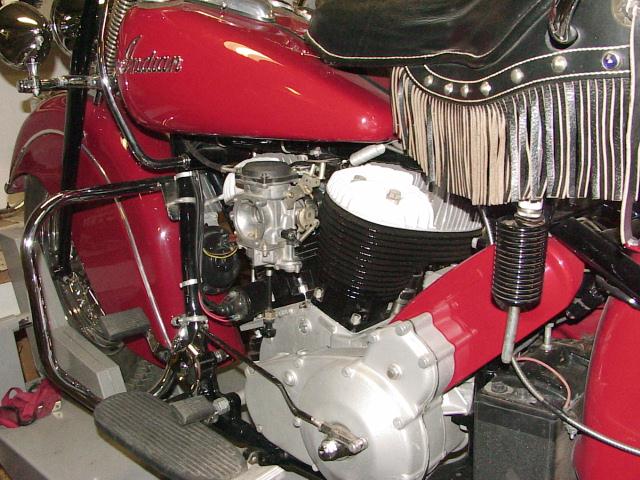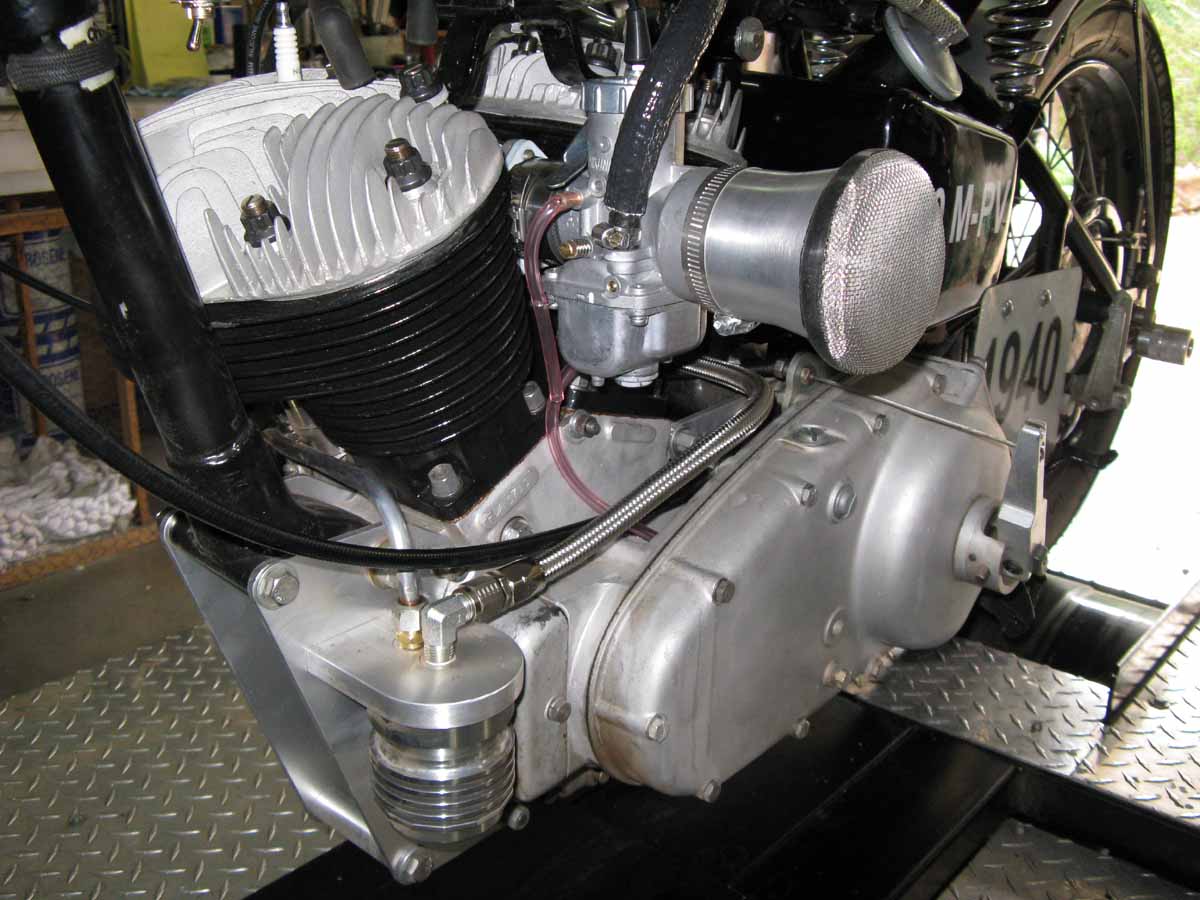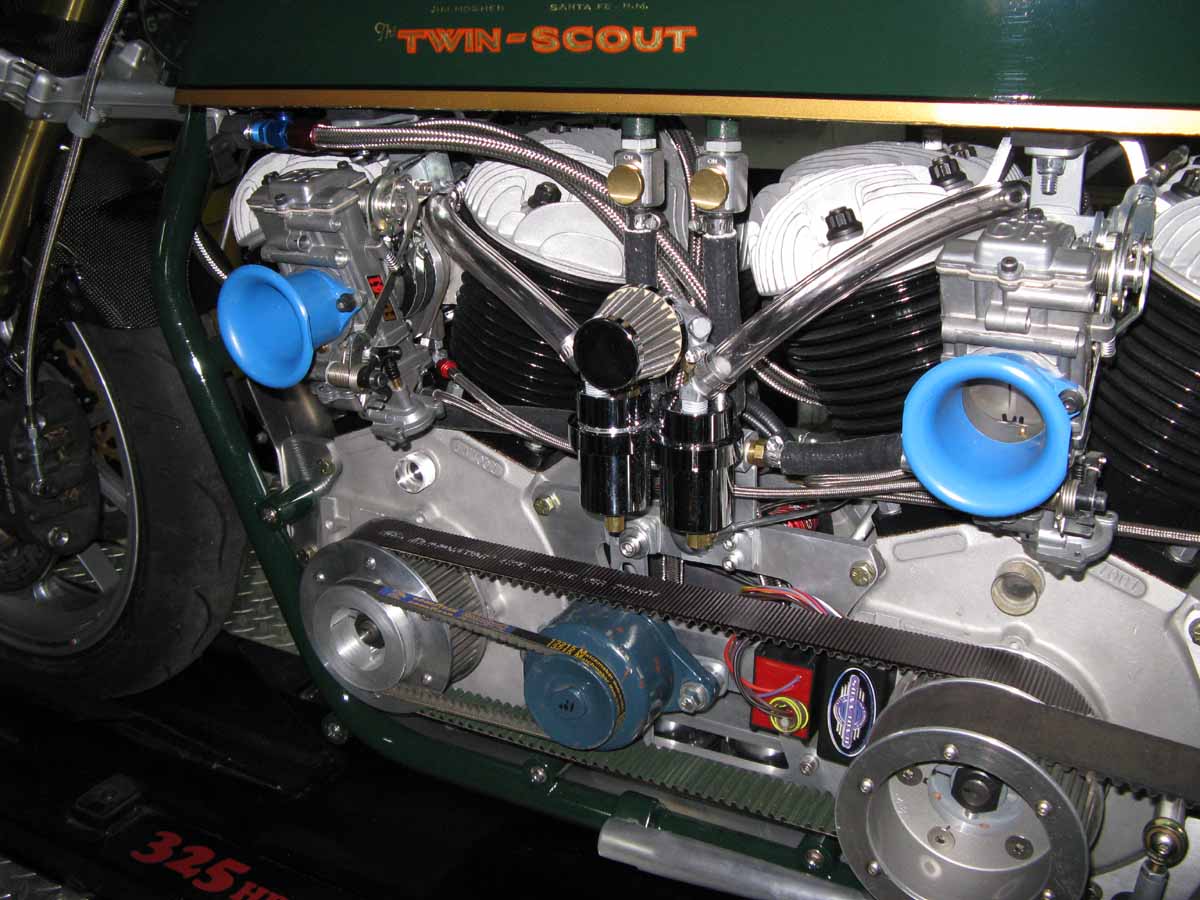Carburetors for Indians

Linkert Carbs
If you know me, or have spoken to me, then you know that I just HATE Linkert carbs. I guess that they were OK for the job at hand back in the 30's, and 40's. Back then, fuel was very different, and the roads were nothing like we have today. Modern fuel has changed so very much since then, that a Linkert now barely works on an Indian. They have a low speed circuit, and a high speed circuit, with virtually no cross-over section. A cross-over is where the low speed is just about to finish, but before that, the high speed circuit is taking over. All other more modern motorcycle carbs have one, or more cross-over circuits, and they are all completely tunable. The Linkert has (2) adjustment screws that act as an adjustable jet (one for low speed, and one for high speed). The adjustability causes a problem, where each click of a needle is pretty much the same as changing one full jet size on an Amal, or Mikuni carb. If you play with your needle settings, you are effectively re-jetting the bike. There is only one perfect jet size for any bike to reach peak power.
Another problem with the Linkert is that the low speed circuit controls the idle mixture, and low speed jetting at the same time. A good idle setting could be wrong for very slight throttle opening positions. All newer carbs have a low speed jet, that can be selected for best low speed running, and an idle mixture screw to adjust the mixture for idling only (seperate functions). The Linkert's high speed circuit has no form of enrichment device, which is needed for too much throttle at too low of an RPM. Usually, a newer carb will have either an accelerator pump, or a specific cut-away for a slide carb. The Linkert just goes very lean with too much throttle too soon. Another problem is the fuel nozzle (emulsion tube). It has a series of small holes, which most people don't understand. The small holes are air holes, and they are not for mixing air with the fuel. That happens naturally, when the fuel enters the venturi. The small holes serve as a delay circuit, so the fuel doesn't rise too soon, before the low speed circuit finishes. The fuel nozzle for the "M-Bonn" or 80" carbs have holes that are too big. There is a huge lean spot between the low speed, and high speed circuits, and it can really be felt around 30 MPH. NEVER use the bigger holed fuel nozzles, unless you want to replace your pistons! The Bonneville, and 80" carbs also had larger diameter venturis (from 1 1/16" up to 1 1/8"). This helps more flow at higher RPM, but at a little cost of low RPM power. Still, NEVER use the Bonneville or 80" fuel nozzle! The larger the air holes in the nozzle, the higher the speed of air in the venturi must be to make enough vacuum to lift the fuel into the venturi.
Another problem with Linkerts are the floats. There have been so many choices for float materials, and particularly their weights. A float is supposed to displace fuel, and float! Brass floats, DON'T! Cork floats fail, but the new black plastic floats seem pretty good. The proper setting for a float is, where, when the float is all the way up, closing the needle and seat, the top of the float is level with, and 1/4" below the top of the bowl. A correct float setting is important with any carb. If the fuel level is too high, it will have an overly rich nature. Too low of a float level will make the bike always seem lean. This has to do with the venturi velocity induced vacuum signal that has to lift the fuel through the fuel nozzle. It takes more vacuum to lift fuel from a lower location.
Another problem with Linkerts is, that the throttle shaft bushings are almost always worn out, causing an air leak, which effects the low speed running, and idle consistancy. You should always have a new shaft, and bushings, properly reamed, and the butterfly plate set just right.
Tuning Tips for a Linkert
As I have mentioned before, I do all my tuning on my dyno, with an O2 sensor, so I can get the jetting just right. An ideal air/fuel setting "AFR" for a V-Twin, or older type motorcycle is 12.8:1 at wide open throttle (13.0:1 for modern bike motors). I have found that with just (4) clicks of the high speed needle, a perfect setting of 12.9:1 can be brought up to 13.8:1 (too lean), or down to 11.8:1 (too rich). As I said before, each click is like changing one jet step at a time on a Mikuni, or Amal carb. I recommend getting access to a dyno for a "snif". Once you find 12.8:1, carefully count how many clicks there are when turning the high speed screw in all the way. Write that number of clicks down, and save it! Then, turn the screw out to where perfect was. Idle mixture should be near 14:1 AFR. Plus, I do comprehensive ignition advance tests to find peak power. All Indians were timed way too far advanced. Each carb installation requires different timing specs. A Linkert on a Chief (either 74" or 80") needs exactly 29 degrees at full advance. A Scout needs (30 degrees of full advance). In all cases, full retard should be at TDC. You will need to modify your upper timing bracket to limit the amount of sweep from retard to advance.
Also, I like a K&N filter in all cases. One of the problems with K&N's, though is that they are often spec'd too small for the application. In most cases, I wash out the red filter oil with de-greaser, so they breath better. They will still clean the air better than any other air cleaner. Never use a sponge, or Brillo pad type element!
Keihin 41mm CV Carb for Indian Chiefs

If you know me, or have spoken to me before, then you know that I LOVE the Keihin 41mm CV carb. It was designed for use on Harley-Davidson V-Twins from 1988 through 2006. There are millions of them out there. They are essentially all the same carb, and even though the H-D factory used slightly different jetting, an Indian always needs a suitable jet kit installed for proper performance. I used to use the Dyno-Jet kit for '90's Evo big Twins. Now I use the Yost "Power Tube" jet kit. It has a special emulsion tube, where it has a tube within a tube, with a bunch of super tiny air holes to better atomize the fuel as it rises up the emulsion tube. They make the best torque of any jet kit that I've tried. The beautiful thing about a CV carb (constant velocity), is that the carb has a normal butterfly opened with the cable, but it also has a slide, that is lifted by venturi flow induced vacuum. The slide rises, and lifts the tapered metering needle, which has (6) notches for fine tuning the mid-range power. The higher the venturi velocity, the higher the slide rises, and the richer the mixture. This setup prevents the motor from "Bogging", if the throttle is opened up too abruptly. By nature, this is an "altitude compensating" carb, where at sea level, the slide will see more air, at higher velocity, thus enrichening the mixture. The opposite occurs at high elevation. I have run my Chiefs at below sea level, as well as over 12,000' in Colorado. The bike has always run flawlessly, with no jet changing required.
The Keihin CV is such an efficient carb, that the ignition timing needs to be radically retarded for the bike to make peak power. Again, all Indians were factory timed way too far (38.5 degrees at full advance!). The CV needs 22 degrees of full advance, and retard back to TDC. This is because the fuel is atomized so well, that it is much more willing to ignite. On my own '47 80" Bonneville Chief, I saw an increase in power of 40%, an increase in fuel milage from 38 mpg to 53 mpg, while my cylinder temps dropped 150 degrees farenheit! On a new top-end rebuild, a Keihin CV will help to keep the cylinder bores round, and the piston/ring wear looks much better than with a Linkert. On a Linkert equipped motor, you will find very black plugs, and pipes. This is from un-burnt fuel being deposited. With the Keihin CV, the plugs will burn tan, and the pipe will be much cleaner. I installed a Keihin CV carb on Mike Breeding's 1938 ULH, and the power went up by 70%. I had to run his advance back to 30 degrees full advance.
The Keihin CV is much too big for a Scout (even a 58" Scout). In Europe, they are promoting the CV for 741's! That is just too much carb for those little motors to generate enough venturi flow to properly lift the slide at lower rpm's. I spent 3 full days trying to trick a CV to work on a Scout. There is just not enough motor there to work well with a 41mm CV! I have considered finding some smaller Honda Keihin CV's to experiment with. I think that a 34mm or 35mm CV with a jet kit would be ideal for a Scout, or 741.
Carb Options for Scouts

As I just mentioned, I do not recommend the Keihin 41mm CV carb for Scouts, and 741's. I have had very god luck with Mikuni VM "Round Slide" carbs, though. I feel that the smaller body 34VM Mikuni is sized right for a 45" Scout, or 741. The larger body 36VM is more suited for 58" Scouts. You can make a simple flange mount manifold adapter to mount to the factory manifold. Bruce Argetsinger of "Enfield Racing" is now making a series of new bronze manifolds to accept the 36VM, or 38VM Mikunis. I prefer the 36VM for Stroker Scouts, for better throttle response, and the 36VM is the same bore size as the manifold anyway!
For an air cleaner, I have found a certain K&N that mounts to the 36VM, and has a round element about 6" diameter, and closed off flat at the outer side. You can actually silicone glue the chrome Indian Script cover to this rubber flat outer surface. There are also some velocity stack options out there as well. In the future, I will offer exact jetting specs for these carbs, but for now, all I did for the smaller, and larger carbs was to raise the needles by (1) notch, and set the idle speed. They worked great right out of the box. More later. Some kind of a carb support bracket MUST be made to support the carb from moving, or it will loosen the manifold at the cylinders! Either weld a tab on the bottom of the manifold adapter, or make a bracket that comes off the float bowl screws. Obviously, you will need to change out the throttle grip with a modern style (non-original).
While we are discussing Mikunis, the Amal Mk1 Concentric carbs are also a good choice. I have been told from good authority that the Mikuni was designed after the Amal Mk1 carb, so the tuning procedure is identical. They come in (3) sizes: 928, 930, and 932 (28mm, 30mm, and 32mm). These would be perfect for 741's, or Scouts. They are "bolt-on", so a simple manifold adapter can be made. Don't forget the carb suport bracket!
Let's Go Racing!

What you see here are a pair of Keihin 41mm FCR "Flat Slides". This is the very best carb ever built for a motorcycle. They are for big bore racing dirt bikes, and also Super-Bikes. They come in the following sizes:33mm, 35mm, 37mm, 39mm, and 41mm. The 39mm's are spec'd for Sportsters, while the 41mm is spec'd for Big Twin H-D's. I chose (2) of the 41mm's for my Twin-Scout, and they work flawlessly. They have an accelerator pump, and chokes. They are high tech, with alot of options, like air cleaner/air box mounts or velocity stacks. They have interchangeable outlets, so you can adapt them to various sized manifolds. They are not cheap at around $900.00 retail, but there is no better carb anywhere! On our Bonneville Land Speed racing Norton 873, I swapped out (2) Amal Mk2 36's for (2) Keihin FCR 39mm's, and we picked up 20 rear wheel HP!
If you look closely at the front carb, you can barely see my Nitrous Oxide hoses, and fogger installed in my manifold adapter. These carbs work very well with NOS as well.
CONTACT INFORMATION:
James R. Mosher
(505) 466-7870






